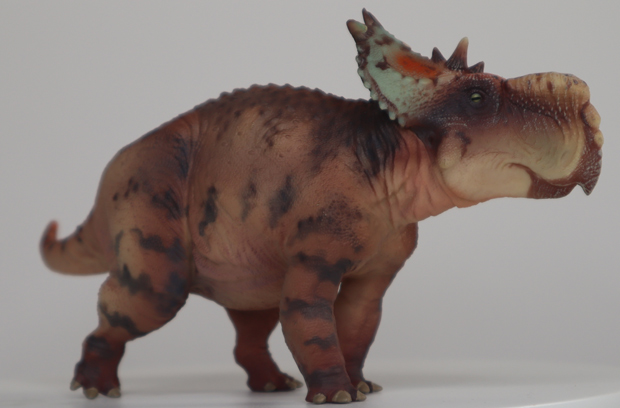Staff from the Philip J. Currie Museum (Wembley, Alberta, Canada) have safely removed a massive Pachyrhinosaurus lakustai fossil skull from the Pipestone Creek Bonebed. The specimen nicknamed “Big Sam” is estimated to weigh around two hundred and seventy kilograms (six hundred pounds). The famous Pipestone Creek site is one of the densest dinosaur fossil deposits known. The remains of hundreds of horned dinosaurs (P. lakustai) have been excavated. Parts of the site have around three hundred individual fossils per square metre. “Big Sam” is the first complete skull to have been found at the site for more than a decade,

“Big Sam” the Pachyrhinosaurus lakustai skull wrapped in plaster and burlap. Picture credit: Philip J. Currie Dinosaur Museum.
Picture credit: The Philip J. Currie Dinosaur Museum
The Pipestone Creek Bonebed
The Pipestone Creek bonebed deposits constitute part of the Wapiti Formation. These strata were laid down during the Late Cretaceous. This remarkable site has yielded an exceptional fauna dominated by abundant remains of the centrosaurine ceratopsian Pachyrhinosaurus. However, Lambeosaurus and Edmontosaurus along with ankylosaurs and theropods have also been recorded from the Wapiti Formation. The Pachyrhinosaurus skull measures over a metre in length. It is one of the largest ceratopsid skulls to have been found in northern Alberta.

Digging away at the underlying sediment to prepare “Big Sam” for flipping prior to extraction. Picture credit: Philip J. Currie Dinosaur Museum.
Picture credit: The Philip J. Currie Dinosaur Museum
The fossil skull is preserved upside-down and with its head frill still attached, a preservation event that has not previously been documented. A field team from the Phillip J. Currie Museum have spent the last two summers meticulously mapping, excavating and jacketing the skull ready for transporting away from the quarry.

Inspecting the underside of the Pachyrhinosaurus lakustai skull jacket as “Big Sam” is prepared for transport. Picture credit: Philip J. Currie Dinosaur Museum.
Picture credit: The Philip J. Currie Dinosaur Museum
Pachyrhinosaurus lakustai
Pachyrhinosaurus lakustai is one of three Pachyrhinosaurus species that have been named. It is the geologically oldest species, having lived around 73 million years ago (Campanian stage of the Late Cretaceous). This species was formally named and described in 2008 (Currie, Langston and Tanke).
Pachyrhinosaurus was a smaller, older cousin of the Triceratops, with a big, bony protrusion on its nose instead of a nose horn.

The Haolonggood Pachyrhinosaurus dinosaur model (LvFang) photographed in the studio. Picture credit: Everything Dinosaur.
Picture credit: Everything Dinosaur
Dr Emily Bamforth, the curator at the Philip J. Currie Museum commented in an email sent to Everything Dinosaur:
“We were very excited to finally have ‘Big Sam’, the skull of a Pachyrhinosaurus lakustai we recently collect from the Pipestone Creek Bonebed, safe in our lab! I noticed that you do carry two models of P. lakustai, which is awesome. We actually use the Haolonggood Pachyrhinosaurus and Edmontosaurus for our outreach and education programmes here.”
To view the range of Haolonggood prehistoric animal figures in stock: Haolonggood Dinosaur Models.
Extracting the Fossil Skull
Once the three hundred or so other bones had been carefully removed from the surrounding area, the Museum team began the process of turning the jacketed fossil over and securing it ready for its journey away from the dig site.

“Big Sam” is carefully winched onto a trolley for transport away from the quarry. Picture credit: Philip J. Currie Dinosaur Museum.
Picture credit: The Philip J. Currie Dinosaur Museum
The huge block was slowly but surely winched up onto a trolley so that staff and volunteers could take this important fossil discovery to the preparation laboratory at the museum. Laboratory technicians will then begin the laborious process of removing the fossil bones from the matrix allowing “Big Sam” to be seen in its glory.

Team members carefully escort the Pachyrhinosaurus skull fossil away from the quarry. The fossil will spend many months in the preparation lab being cleaned and prepared. Picture credit: Philip J. Currie Dinosaur Museum.
Picture credit: The Philip J. Currie Dinosaur Museum
Members of the public can visit and see the skull undergoing cleaning and preparation. The objective is to eventually put this remarkable fossil specimen on display.
Everything Dinosaur acknowledges the assistance of a media release from the Philip J. Currie Dinosaur Museum in the compilation of this article.





Leave A Comment